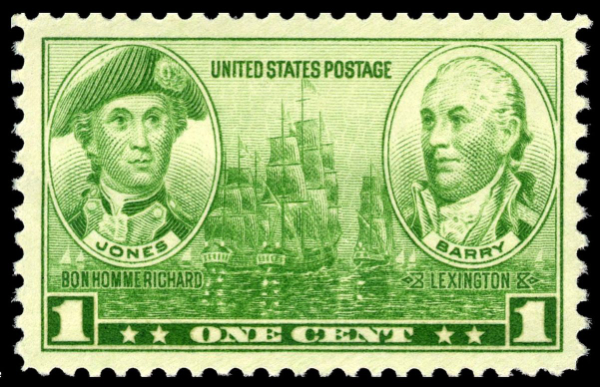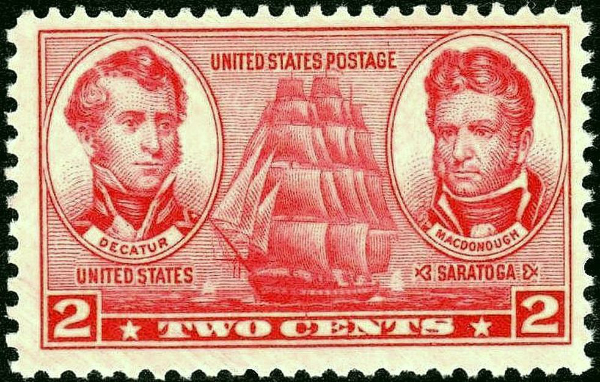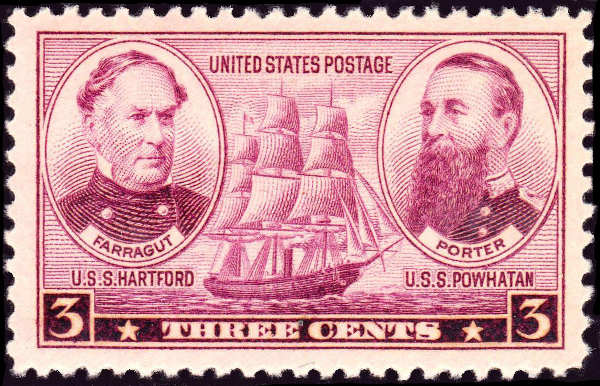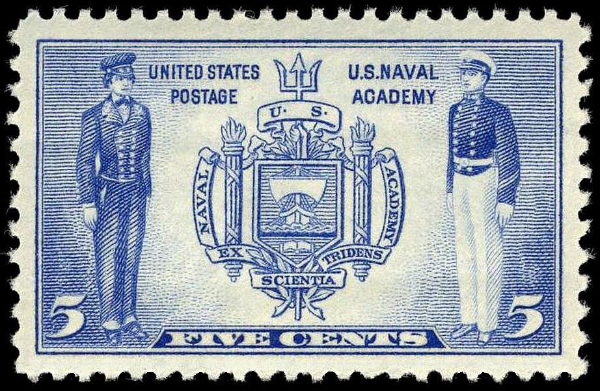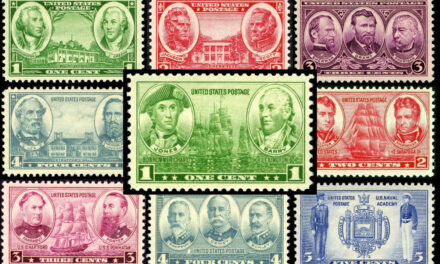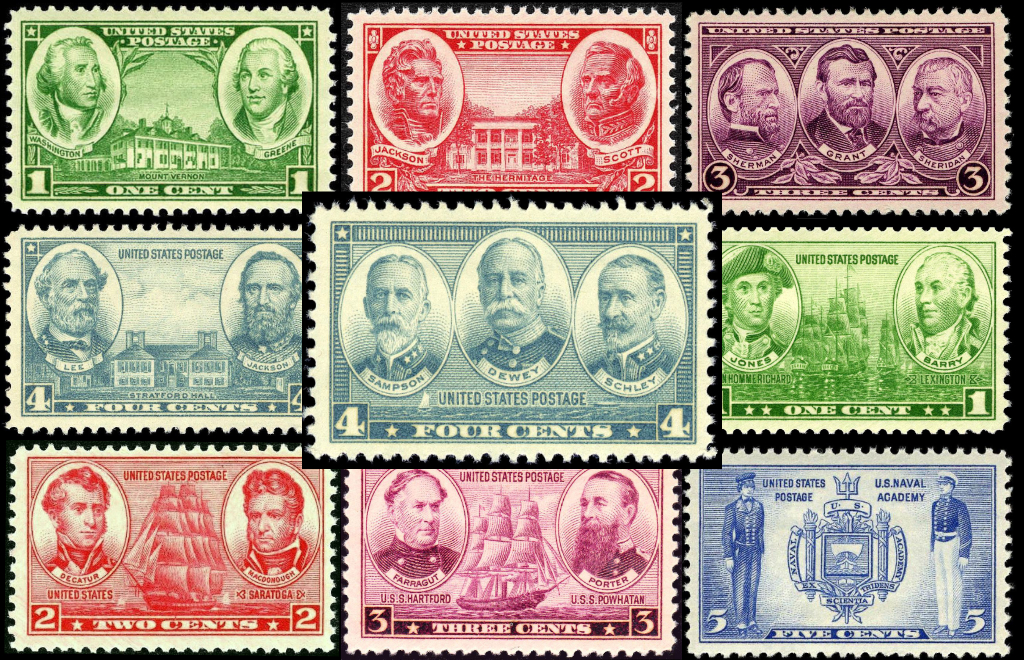
4-Cent 1937 Navy Stamp: William T. Sampson, George Dewey, and Winfield Scott Schley
The 4-cent 1937 Navy stamp features portraits of the three U.S. Navy flag officers who had combat commands in the Spanish-American War: Rear Admiral William T. Sampson, Admiral of the Navy George Dewey, and Rear Admiral Winfield Scott Schley.
This grouping is especially interesting because Sampson and Schley became involved in a controversy over their roles in the battle for which they are most famous, and Dewey was a member of the Navy’s court of inquiry that ruled on the matter.
The stamp is the fourth in a series of five stamps that were issued between December 1936 and May 1937 to commemorate some of the most important American naval officers of the 18th and 19th centuries. A parallel set of Army commemoratives, including the 4-cent Army stamp featuring Confederate Generals Robert E. Lee and Stonewall Jackson, along with Lee’s Virginia birthplace, Stratford Hall, was issued on the same dates as the Navy stamps.
The Design and Issuance of the 4-Cent 1937 Navy Stamp
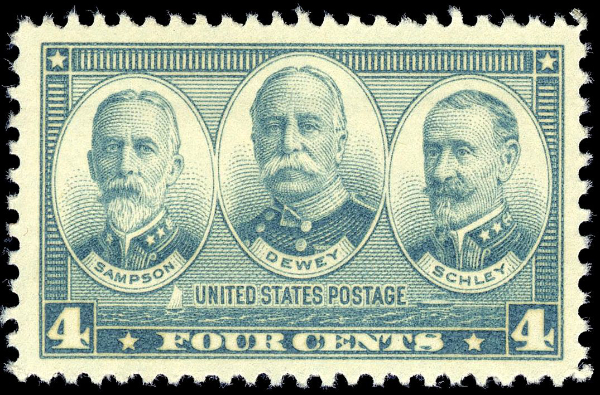
The 4-cent 1937 Navy stamp features Admirals William T. Sampson, George Dewey, and Winfield Scott Schley, naval heroes of the Spanish-American War. (U.S. Post Office — U.S. Bureau of Engraving and Printing, Public domain, via Wikimedia Commons)
The Other Stamps in the 1936–1937 Navy Series
Rear Admiral William T. Sampson (1840–1902)
Celebrated for his role in the Battle of Santiago de Cuba in the Spanish-American War, William Thomas Sampson had a successful Navy career from the outset, graduating first in his class at the Naval Academy in 1861.
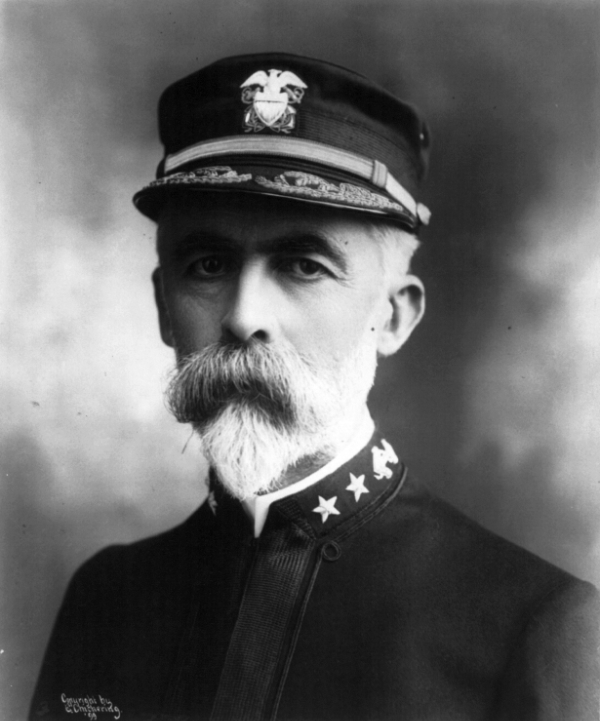
Admiral William T. Sampson, U.S. Navy. (Elmer Chickering, Public domain, via Wikimedia Commons)
He served as an instructor at the Academy after graduation, and then saw active duty during the Civil War as an officer aboard the monitor Patapsco in the South Atlantic Blockading Squadron. Following the war, he again taught at the Naval Academy and held several other important positions, including posts at the Navy’s Bureau of Navigation and the Naval Observatory, and as Officer in Charge of the Naval Torpedo Station in Newport, Rhode Island.
In 1886 Sampson was appointed Superintendent of the Naval Academy, a post that he held until 1890. In 1889 he was promoted to Captain, and in 1897 he took command of the battleship Iowa. After the USS Maine exploded in Havana Harbor in February 1898, Sampson was named President of the Board of Inquiry in charge of the investigation. A month later, he was given the temporary rank of Rear Admiral and placed in charge of the North Atlantic Squadron.
Sampson Initiates the Cuban Blockade
With the United States on the brink of declaring war on Spain in April 1898, Sampson sailed for Cuba on the flagship USS New York. He supervised the beginning of the Cuban blockade, then undertook a bombardment of San Juan, Puerto Rico, that culminated in the capture of the city in a joint Army-Navy operation.
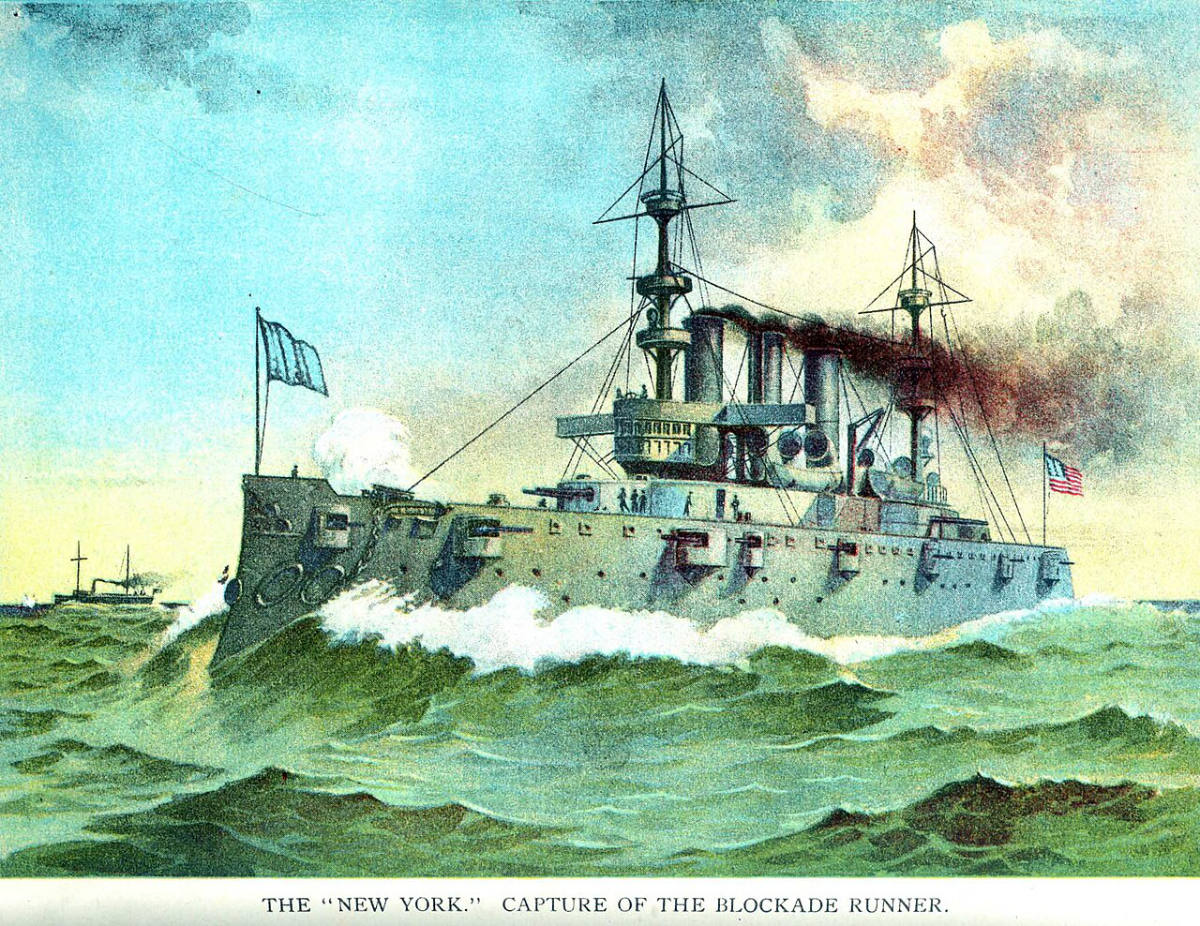
The USS New York 1898. (Murat Halstead, Public domain, via Wikimedia Commons)
Santiago Bay: A Quarrel over Credit for the Victory
Sampson returned to Cuba, where he planned strategy for engaging the Spanish fleet under Admiral Pascual Cervera y Topete at Santiago. However, on July 3, the battle with Cervera began while Sampson was ashore in a planning conference. The American naval forces, under the command of Rear Admiral Winfield Scott Schley in Sampson’s absence, completely destroyed the Spanish fleet.
Although Sampson did not actively participate in the fighting, he sent a famous message offering Cervera’s ships to the nation as a Fourth of July present from the fleet “under my command.” Schley objected to Sampson taking credit for the victory. The quarrel between Sampson and Schley and their respective supporters led Schley to request a court of inquiry.
Sampson’s Short Post-War Career
After the war, Sampson was named Commandant of the Boston Navy Yard. He retired from the Navy in 1902 and died later the same year.
Admiral of the Navy George Dewey (1837–1917)
George Dewey is the only person ever to hold the rank of Admiral of the Navy, a special rank created by Act of Congress in 1899. He was commissioned as Admiral of the Navy in 1903, retroactive to 1899, in recognition of his decisive role in winning the Spanish-American War.

George Dewey, Admiral U.S.N., from a photo taken July 21 1899. (Library of Congress Prints and Photographs Division, Washington, D.C.)
Dewey attended the Norwich Military School in Vermont, followed by the United States Naval Academy, from which he graduated in 1858. After graduation, he served as a midshipman on the USS Wabash in the Mediterranean. During the Civil War, Dewey was assigned to the West Gulf Blockading Squadron under Commander David Dixon Porter. As executive lieutenant on the Mississippi, Dewey played a significant role in the Battle of Forts Jackson and St. Philip, the capture of New Orleans, and the Battle of Port Hudson, Louisiana.
In 1864 Dewey was reassigned as executive officer of the man-of-war Colorado in the North Atlantic Blockading Squadron. He was recognized for his tactical ability in the assault on Fort Fisher in January 1865, the last significant naval engagement of the war. Soon thereafter he was promoted to lieutenant-commander.
Dewey’s Peacetime Assignments
Dewey remained on active duty after the Civil War. His assignments over the next thirty years were varied, including a second tour of duty as executive officer of the Colorado, two years as an instructor at the Naval Academy, and four years as commander of the Narragansett working on the Pacific Coast Survey.
From 1880 to 1882 he was in Washington D.C. serving as a lighthouse inspector and secretary of the Lighthouse Board. In 1884 he was promoted to captain and given command first of the USS Dolphin and then of the Pensacola. In the mid-1890s he spent additional years in Washington with the Lighthouse Board and the Board of Inspection and Survey.
The Spanish-American War: Victory at Manila Bay
In 1896 Dewey was commissioned as a commodore. In 1897, having requested a return to sea duty, he was placed in command of the Asiatic Squadron. Anticipating imminent war with Spain, Dewey gathered the ships of the squadron at Hong Kong and replenished their fuel, ammunition, and other supplies. When war was declared in April, Dewey received orders to proceed to the Philippines and attack the Spanish fleet at Manila Bay.
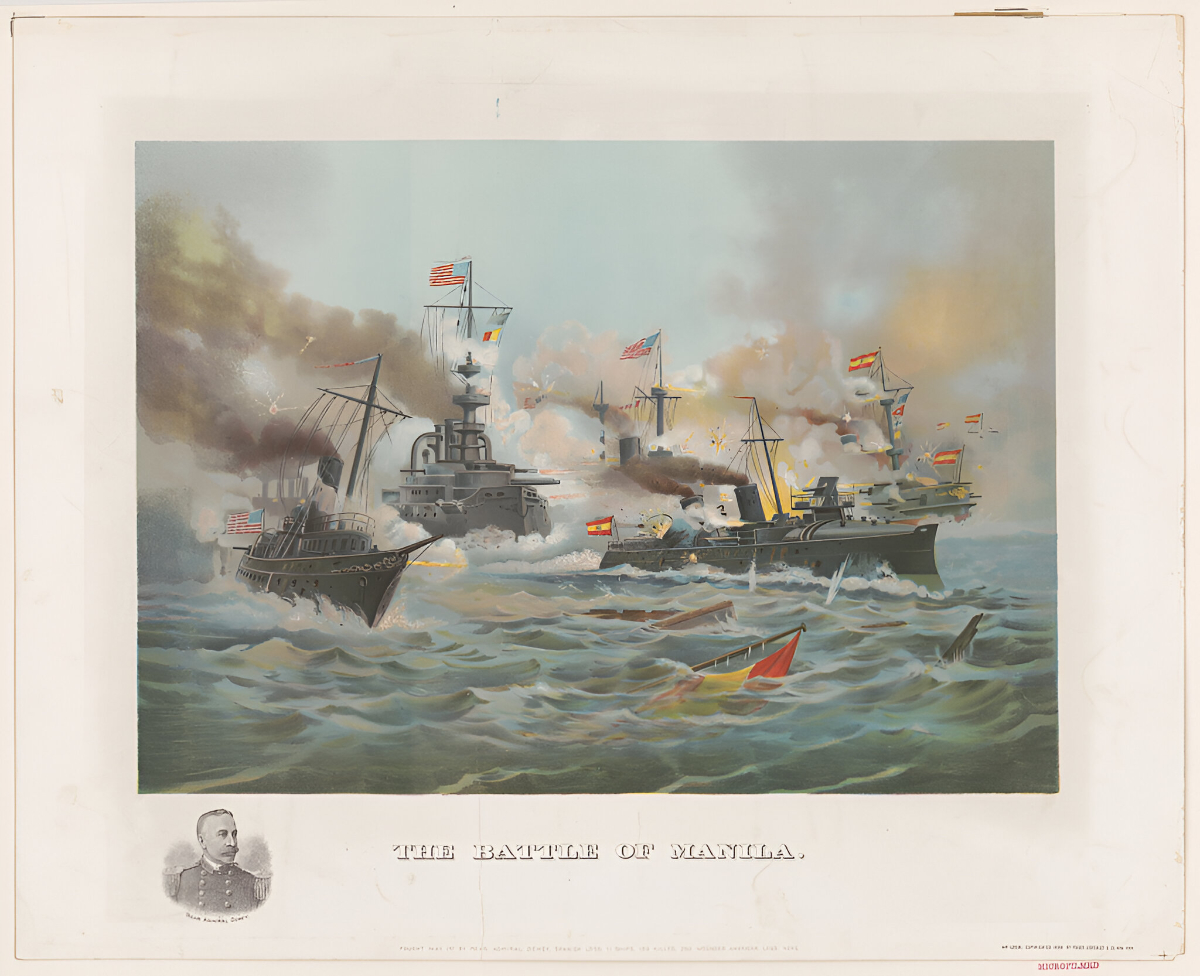
The Battle of Manila, with Admiral Dewey's flagship, the U.S.S. Olympia, at center. (Color chromolithograph, c. 1898, Library of Congress Prints and Photographs Division, Washington, D.C.)
At dawn on May 1, Dewey gave the famous order to attack—”You may fire when you are ready, Gridley”—to Charles Vernon Gridley, captain of Dewey’s flagship USS Olympia. Within six hours, Dewey had captured or sunk the entire Spanish fleet commanded by Admiral Patricio Montojo y Pasarón and overcome the Spanish shore defenses.
Dewey’s Later Life: A Policymaker and a Potential President
Dewey’s swift and decisive victory led to worldwide recognition of the United States as a naval power. He was welcomed home as a hero. Dewey agreed to run for President in the 1900 election but dropped out of the race after about six weeks and endorsed William McKinley. From 1900 to his death in 1917, Admiral Dewey served as president of the policy-making General Board of the Navy Department.
Rear Admiral Winfield Scott Schley (1839–1911)
After Winfield Scott Schley’s graduation from the U.S. Naval Academy in 1860, he served as a midshipman on an expedition to China and Japan. During the Civil War, he served first in the Western Gulf Squadron, where he participated in the capture of Port Hudson, Louisiana, in 1863, and later in the Pacific Squadron. He was promoted to lieutenant in 1862 and lieutenant commander in 1866.

Rear Admiral Winfield Scott Schley, circa 1899. (Pach Brothers, Public domain, via Wikimedia Commons)
Schley taught at the Naval Academy from 1866 to 1869 and again from 1872 to 1875. Between the two stints at the academy, he served in the Asiatic Station and participated in the U.S. Korean Expedition in 1871. He was promoted to commander in 1874 and served in various capacities in Europe, on the coast of Africa, and in the South Atlantic. Among his commands were USS Essex, USS Baltimore, and USS New York. Schley was also assigned to several posts in the Lighthouse Bureau and served as chairman of the Lighthouse Board in 1897–1898.
Schley’s Mission to Rescue Greely’s Arctic Expedition
In 1884, Schley commanded a relief operation to rescue Lieutenant Adolphus Greely’s trapped Lady Franklin Bay Expedition in the Arctic after several others had failed. Traveling through 1400 miles of ice, Schley and his crew succeeded in rescuing Greely and six of his companions. Schley co-wrote a book about the rescue in 1885.
Commanding the Flying Squadron in the Spanish-American War
Schley was commissioned as a commodore in 1898. At the outbreak of the Spanish-American War, he was placed in charge of the Flying Squadron, commanding the flagship USS Brooklyn. Admiral Sampson, his superior officer as head of the North Atlantic Squadron, sent him in pursuit of Spanish Admiral Cervera, first to Cienfuegos and then to Santiago de Cuba. Schley at first declined to go to Santiago but ultimately found his way there and assisted Sampson with a blockade of the harbor to trap the Spanish fleet.
Santiago de Cuba: Was Schley the Hero?
On July 3, the Spanish ships attempted to evade the blockade while Sampson was ashore. After a near collision between the Brooklyn and another U.S. ship gave the Spanish fleet an opportunity to escape, Schley’s squadron pursued and defeated Admiral Cervera and destroyed the Spanish ships.
Sampson’s victory message made no mention of Schley’s role, and in fact Sampson believed that Schley had been insubordinate and careless. The public, however, viewed Schley as the hero of the Battle of Santiago de Cuba. In 1899 Schley was commissioned as a Rear Admiral and given command of the South Atlantic Squadron. He retired from active duty in 1901.
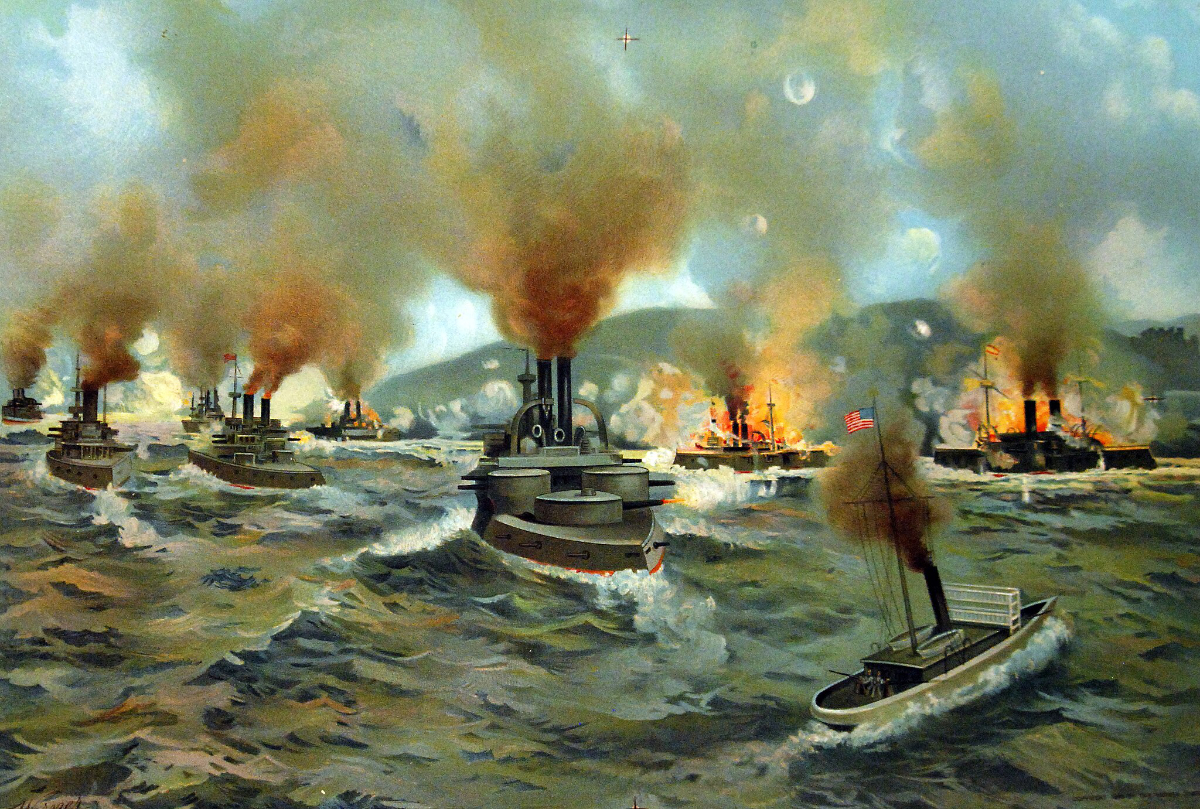
Naval battle at Santiago de Cuba, July 3rd, 1898. (National Museum of the U.S. Navy, Public domain, via Wikimedia Commons)
Also in 1901, at Schley’s request, the Navy convened a court of inquiry, comprised of Admiral George Dewey and two other admirals, to investigate charges made against Schley for his conduct before and during the Battle of Santiago. The majority found that Schley had engaged in misconduct and shown poor judgment, but recommended that no action be taken. Admiral Dewey, however, issued a minority report praising Schley and giving him credit for the victory.
Although the findings of the majority went against Schley and were ultimately upheld by the Secretary of the Navy and by President Theodore Roosevelt, the publicity of the court of inquiry enhanced Schley’s status as a war hero.
An Introduction to American Naval History
The Spanish-American War was the most recent war to be included in the 1936–1937 Army-Navy commemorative stamp series. As the most famous naval officers in that war, Admirals William T. Sampson, George Dewey, Winfield Scott Schley were the natural choices to be honored on the 4-cent 1937 Navy stamp. The fact that they were all involved in the controversy over Schley’s conduct in the Battle of Santiago de Cuba adds a bit of intrigue to the grouping on the stamp.
This stamp and the others in the series provide a great way to begin learning about important figures, events, and places in American history. Hundreds of other commemorative postage stamps tell other parts of the nation’s story, and thousands more stamps of historical interest have been issued worldwide. Collecting stamps, especially commemorative issues, can be a great way to learn about history.
Copyright © Brian Lokker 2012, 2024. An earlier version of this article was published on HubPages.com in 2012 and was subsequently featured on HobbyLark.com.

